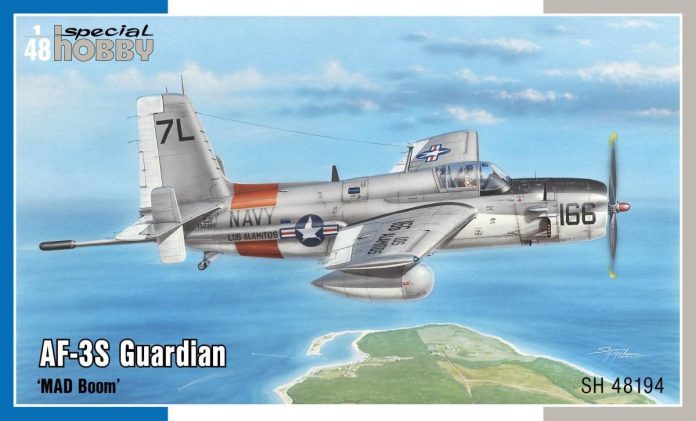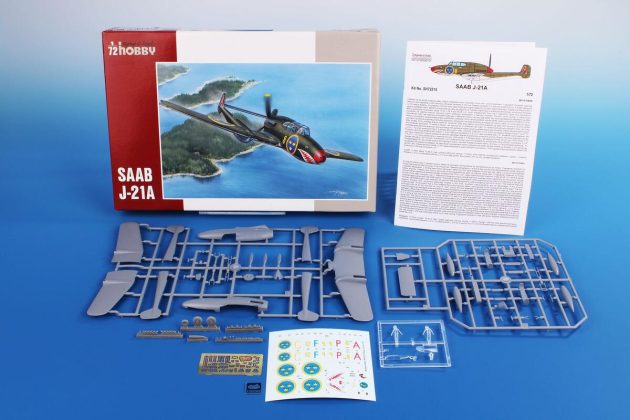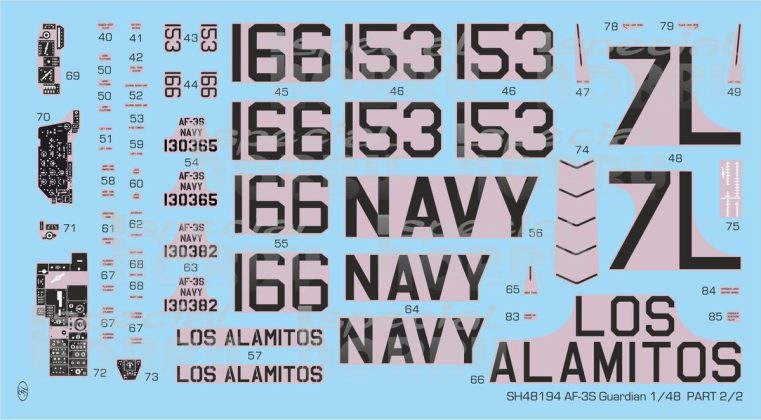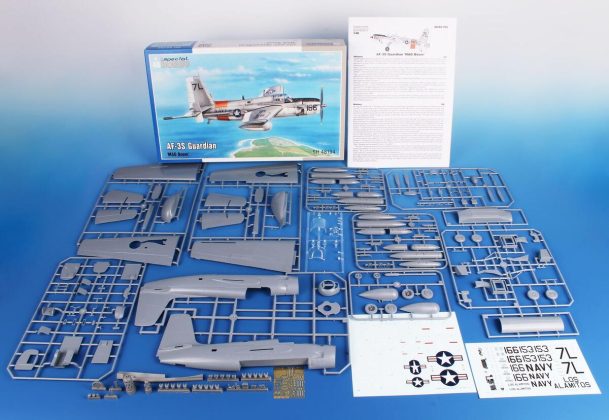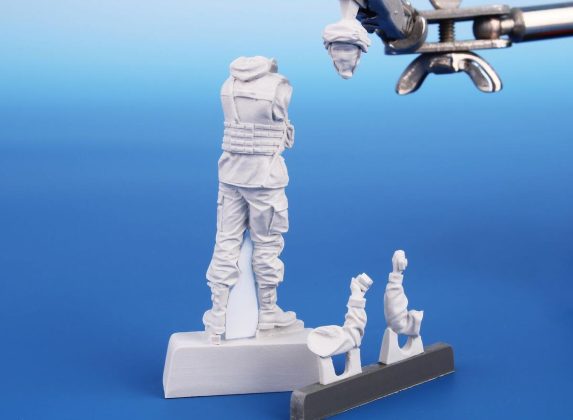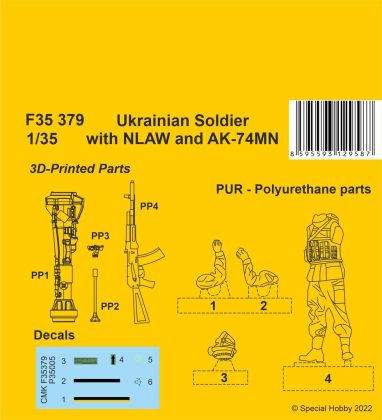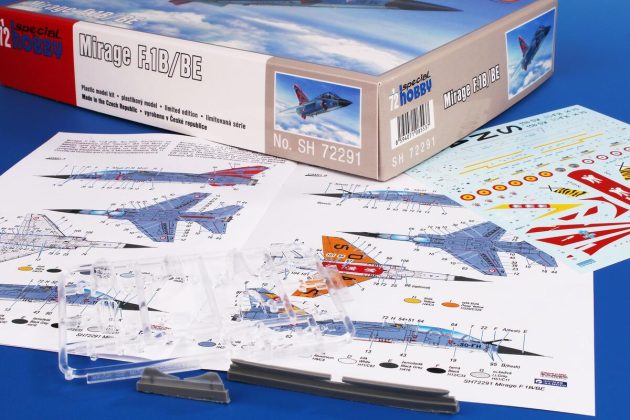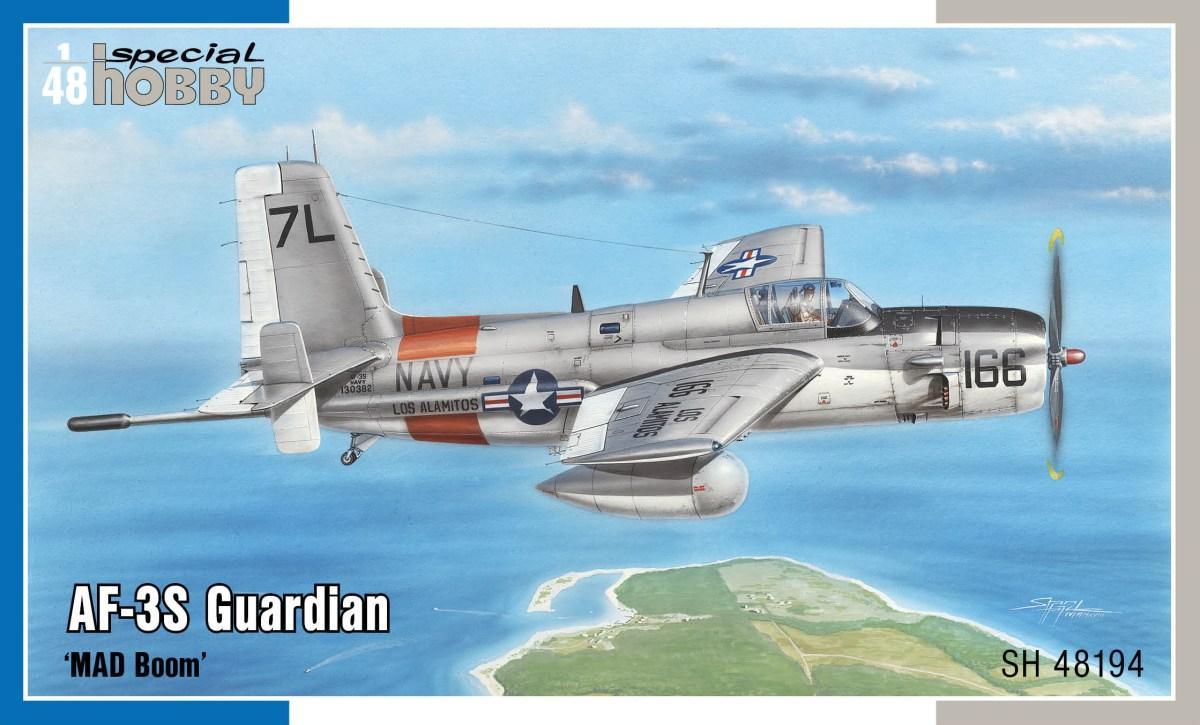 AF-3S Guardian 1/48
AF-3S Guardian 1/48
During the 1950s, the AF-2 Guardian anti-submarine aircraft were operating from the US Navy carriers in so-called Hunter-Killer pairs which consisted of one machine of the AF-2W version performing the Hunter role using its volumous, belly-mounted AP-20 search and early-warning radar to locate enemy’s submarines while the other member of the team was an AF-2S which was the Killer, carrying a variety of offensive anti-submarine weapons, such as torpedoes, depth charges or rockets in the bomb bay or beneath its wings.
The development of the Guardian began during WW2 although the original request from the US Navy had been for a torpedo-bomber. At Grumman, this project was known under G-70 designation, while the Navy recognized it as the XTB3F. This new type was to be propelled by a P&W R-2800 radial engine driving a four-bladed propeller in the nose and a Westinghouse 19XB jet engine mounted in the tail section. The Westinghouse jet was later removed from the specifications, yet before the prototype’s maiden flight, which took place on 19th December 1945. By this time the torpedo bomber role had already been outdated and the Navy asked for the type to be rebuilt into the two above mentioned versions.
The prototype AF-2 (which was the radar-equipped Hunter version) first flew in November 1948 while the AF-2S performed its first flight in January the following year. A year later, the type entered service with the US Navy, later to be joined by a third version, the AF-3S which was basically a AF-2S with a magnetic anomaly detector fitted. The AF-3s were operated both from land bases and aircraft carriers. During the Korea War, the type was used to defend US Navy vessels in the combat zone.
The Guardian was removed from front line service in 1955, remained just with US Naval Reserve units up to 1957. The type became the very first US Navy carrier-based aircraft to be specially built for anti-submarine warfare. It also holds the record for being the largest single-engined, piston-engined aircraft ever to be flown from the US Navy carriers.
Our model of the final, attack version of the Guardian consists of as many as eight styrene runners, one clear sprue, a set of resin parts and a photo-ethed fret. The new AF-3S sprue contains also a new set of mainwheels with the correct number of slots in the hubs and an enlarged stbd wing pod housing more efficient radar to that used in the AF-2S version. The decal sheet caters for four machines, two of which were painted in blue overall per regulations issued later in the war. The VS-20 machine was operated in 1953, at first from NAS Atsugi in Japan, later from aircraft carrier USS Bagoeng Strait. The other blue Guardian belonged to VS-27 and flew from CVS-36 USS Antietam in the Mediterranean in 1953. AF-3Ss machines remained in service with reserve units long enough to receive the new Gray-White scheme, the other two Guardians in our kit offers this scheme as worn by NAS Los Alamitos based machines, the scheme is also accompanied by orange fuselage bands which were used to mark training machines.
Largest single-engined, piston-engined aircraft ever to be operated from aircraft carriers
Finely detailed resin cast engine
Photo etches in the box
Four eye-catching schemes
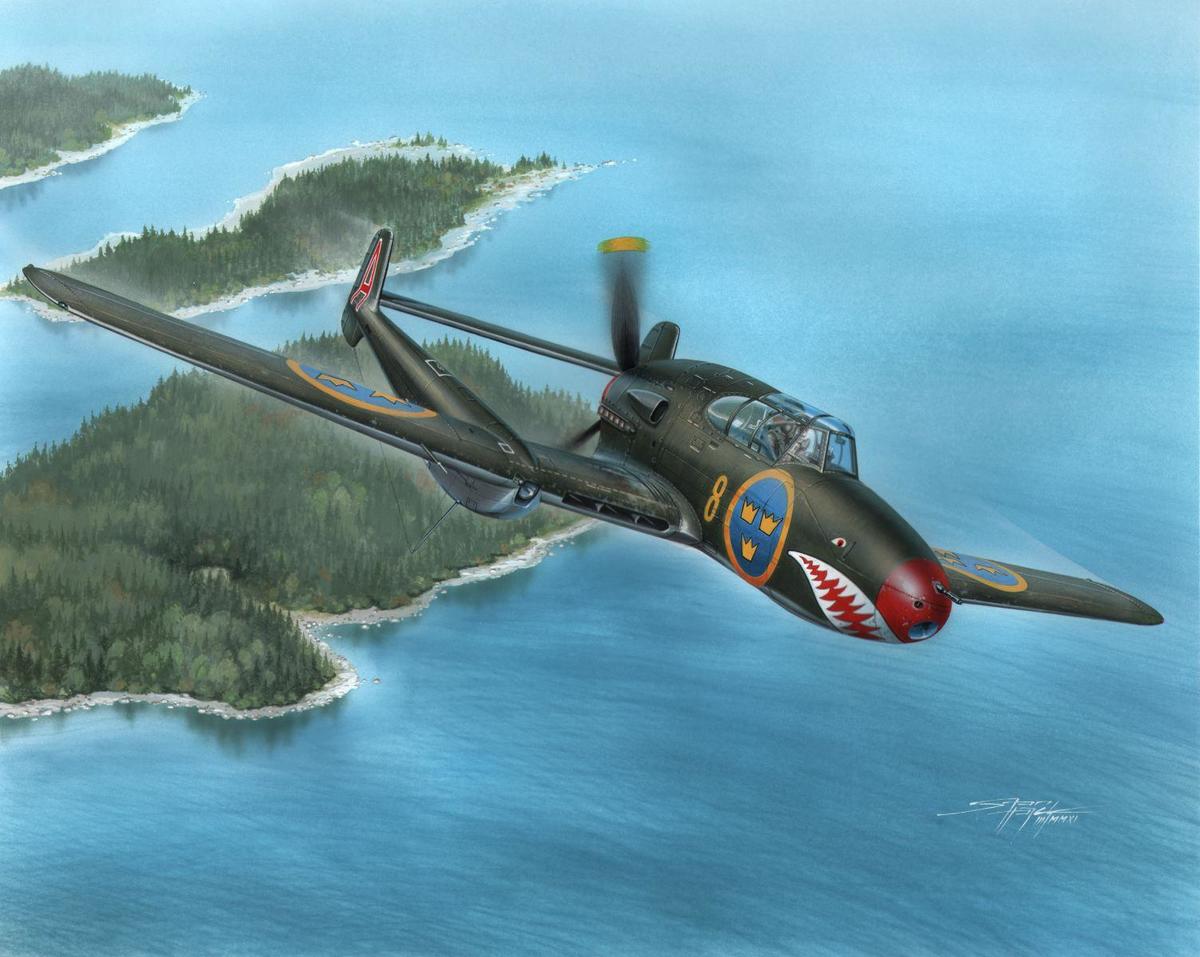 SAAB J-21A 1/72
SAAB J-21A 1/72
During the Second World War, Sweden sought to ensure its neutrality, besides other means, also through a powerful air force. The Flygvapnet (Swedish Air Force) ordered 264 Seversky P-35A US-made fighter aircraft, designated the J-9 in Sweden of which were 60 delivered and also the Vultee Vanguard, to be designated the J-10, of which were none delivered. However,after the US was drawn into the war by the Japanese attack, the US government imposed an embargo on further weapons exports and so Sweden was left with the necessity to take care of its future armament itself. During the war, Sweden managed to design and introduce into service two indigenous fighter types. Apart from the downright auxiliary FFVS J-22, it was the SAAB J-21 which was that company’s first fighter type. Its designer, F.Wänström created a machine of unorthodox construction with two tail booms, a nose-type undercarriage and a pusher engine. The machine offered a perfect view forward to its pilot, the armament was conveniently placed in the nose section, the manoeuvrability was excellent as was the ground handling due to the nose type landing gear. There were some disadvantages too, though, namely problems with cooling the power unit which were synonymous with the type all along its flying career. The first J-21A-1 production machines went to serve with F-9 wing only after the war in Europe had come to the end. The next production batch machines of the J-21A-2 version differed by the armament used and they were operated by wings F-12 abd F-15. The final batch was manufactured in the ground-attack version in 1948 and was known as the A-21A-3. In the fighter role, the J-21 became obsolete rather quickly, but its excellent manoeuvrability at low altitudes and perfect stability during fire made the type a perfect platform for ground attack roles. The J-21A airframe was also the basis for Sweden’s first jet engine-powered type, the J-21R. At first, it was expected that placing the licence-built De Havilland Goblin jet engines into the aiframe should be without any major trouble, but soon it became clear that the improvements were going to be so massive that only about 50% of the airfame can be taken from the piston type. Despite that the new J-21R was very similar to its older sibling. A total of 299 piston engine powered J-21 was built plus 120 more of the J-21R type.
Unusual shape aircraft
Four interesting schemes
Etches and resin parts included
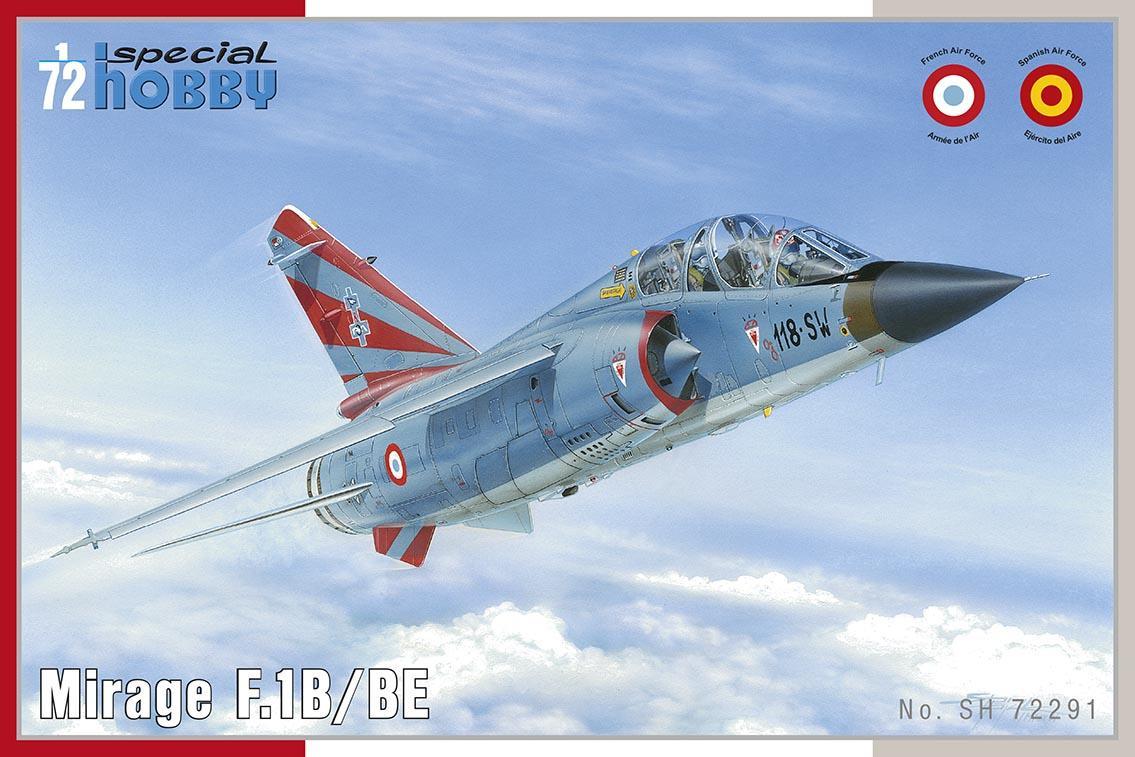 Mirage F.1B 1/72
Mirage F.1B 1/72
The Mirage F.1 came about as a private venture by the French Dassault company. The Armée de l´Air had ordered the build of two prototypes the Mirage F. and F.3 powered with a JTF10 engine. Dassault, however, designed and built one more airframe, smaller than the officially ordered airframes and fitted with the Atar 9K powerplant. The first flight of the Mirage F.1 took place on 23rd December 1966 and production aircraft entered servicewith the French military as the F.1C single seat fighter and F.1B two seater training versions. During their service with France a number of these aircraft were upgraded by fitting of IFR probes which resulted in the designation F.1C-200. The air force also flew dedicated recce and ground-attack versions of the F.1 designated respectively the F.1CR and F.1CT, the latter being converted from the earlier F.1C-200 airframes. A total of 246 Mirage F.1s of all versions served with the French and Dassault also tried to offer the aircraft with a more powerful engine to Belgium, Denmark, the Netherlands and Norway. These countries chose the F-16 instead and the F.1E version remained only as a prototype. Nevertheless, the F.1 was exported successfully further afield. In Europe, the F.1 flew with Spain and Greece, in South America, the Mirage saw service with Ecuador, but both in Africa and Asia, the F.1 airframes were widely used, namely with Gabon, South Africa, Morocco, Libya, Iran, Iraq, Qatar and Kuwait. Flying with these air forces, the famous Mirage F.1 saw service and even hot combat action around the world, including mock fights over the Aegean between Greek´s F.1s and Turkish jets, French aircraft were deployed and used over Chad, Ecuadorian Mirages were put in combat against Peru, South African aircraft successfuly fought Angola-Based Cuban MiG jets and during in the Middle East, Mirages even fought on both sides of the conflict between Iraq and Iran.
This nicely detailed model of the two-seat Mirage F.1B/BE is now re-released and once again back on offer. The kit parts are broken down to seven sprues, one clear sprue, the kit also contains a set of resin details portraying Spanish-specific parts as the differing missile racks or flare dispensers. The Cartograf-printed decal sheet caters for two French-operated airframes, both of with are blue grey on top and aluminum beneath with colourful trim, the third colour option being a Spanish Mirage wearing four-tone scheme with fancy tiger stripes.
Fir this kit we also offer separate masks and many accessories including figures.
Interesting camouflages
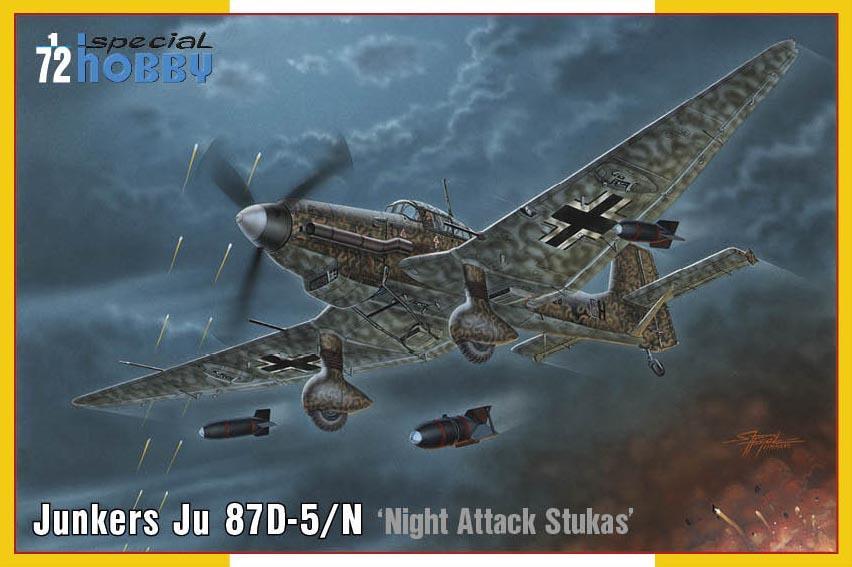 Junkers Ju 87D-5/N/D-8 ‘Night Attack Stukas’ 1/72
Junkers Ju 87D-5/N/D-8 ‘Night Attack Stukas’ 1/72
The top-notch plastic parts of Academy’s Juners Ju 87G-2 are now joined by our own styrene, resin and photo-etched conversion parts which all makes it possible to make the Junkers Ju 87 in the rare D-5/N/D-8 versions. And along all that, the conversion parts also take care of the very few issues the original kit has. These D-5/N/D-8 airfames were almost the last ones of the Stuka family to be flown in the bomber role aand were operated from 1943 until the end of the war. They saw service not only with the Luftwafe, a couple of Axis states operated them, too. Due to the air superiority of the Allies though, these Stukas were most often used at night in ground-attack and bombing missions and as the dive brakes were not needed for such actions, these were often removed and ight type exhausts with flame dampers were introduced on these versions.
The marking schemes and defals of this limited-quantity model kit caters for four Luftwaffe options fitted with two styles of night exhausts made of resin.-
attractive version
nice-looking decal sheet including set of stencils
released in limited quantity
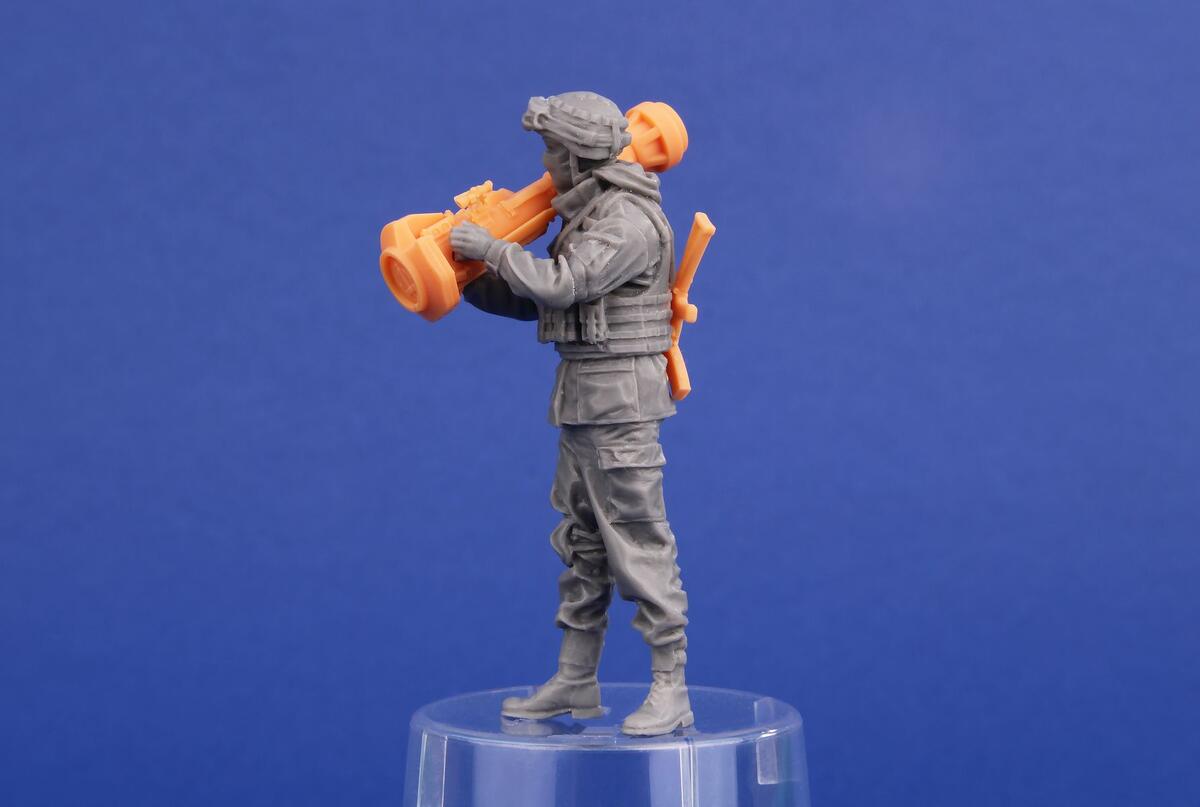 Ukrainian Soldier with NLAW and AK-74MN 1/35
Ukrainian Soldier with NLAW and AK-74MN 1/35
Superbly detailed resin cast figure portraying a Ukrainian troop, a real tank destroyer. The standing soldier is armed with an AK-47MN submachine gun and a NLAW anti-tank missile. The gun and missile are 3D-printed. You will find a stencils decals for the missile in the set, too.
HobbyLink International
Hoblylink International Shop
eBay Store



